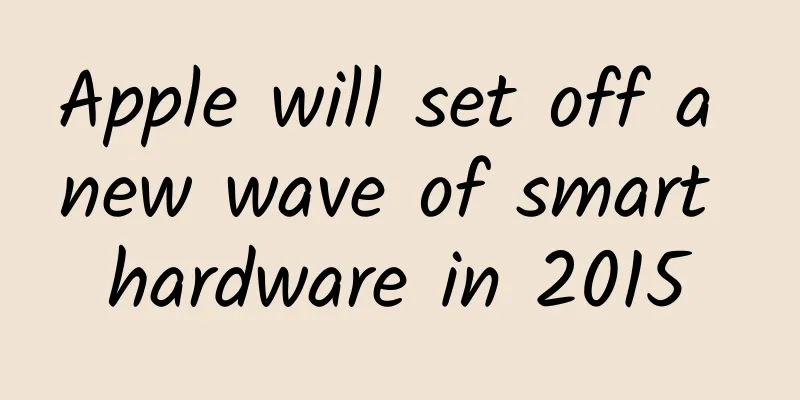Apple will set off a new wave of smart hardware in 2015

|
Although the much-anticipated Apple Watch will not appear at the CES 2015 exhibition, its far-reaching impact on the industry has been clearly demonstrated in the many smart watches and wearable devices that will be unveiled this time. Image source: Apple The promise of increased employee productivity and related applications is positive enough to attract many customers. At the international CES exhibition held this week, more than 500 technology suppliers gathered together to showcase a variety of wearable computing devices in different styles. There are 569 official exhibitors listed on the CES official website, some of which focus on promoting computing chips embedded in clothes and shoes, while others have improved and upgraded wearable computing accessories on the existing basis. Suppliers have also created many smart watches and smart glasses that are already available for commercial use. In addition, some companies have demonstrated how to further improve the intelligence level of wearable devices by coupling personal data with huge data sets in the cloud system. Given the normal popularization process of modern technological solutions, about 90% of manufacturers will completely disappear or give up their attempts in the field of wearable devices within the next three years, and instead show their prowess in the next technological confrontation that will demonstrate significant revolutionary significance. But this does not mean that wearable computing will disappear. Even if only about 10% of the exhibitors at this CES continue to stick to this path, it means that more than 50 companies will continue to be active in the wearable computing market. And it is certain that more fresh blood will be injected into this industry in the future development process. The focus of this year's CES 2015 conference was on how wearable technology - especially smart watches - will shine in the field of productivity. "The demand for wearable technology is greater than many people think," Forrester analyst JP Gownder wrote in a December article for marketing executives. "Despite the hype surrounding wearables -- and the arguments against them -- the data clearly shows that there is a surprising amount of real demand for wearables among individuals and businesses." Smartwatches have come a long way since they debuted at last year's CES. Samsung has five different models, including the recently announced Gear S, a $350 smartwatch with a 2-inch curved display and voice calls over all wireless networks. Google's Android Wear operating system has appeared on the Moto 360 and LG G Watch. Microsoft has also unveiled its Smart Band, a health-focused smartwatch. Intel's latest offering, MICA, is a $495 gem-studded smart bracelet that works over 3G AT&T's cellular data network without a smartphone. Apple Watch: The focus of attention and tracking Apple is undoubtedly the biggest player in this space, having announced that it will release the Apple Watch in 2015, most likely in the second quarter. Although Apple will not be showing the product at CES, its market dominance is unquestionable. Recent discussions on investor blogs have focused on whether Apple can achieve the desired sales performance in the first year of the Apple Watch, with the lowest forecast being 3 million units and the highest being 30 million units. Considering the huge success Apple has achieved with the iPhone and iPad, the Apple Watch is bound to become the most noteworthy technology product in 2015. If Apple can sell 30 million Apple Watches in 2015, it would account for 75% of the 40 million smartwatches that Gartner predicts will be sold worldwide in 2015. However, current forecasts for the Apple Watch and other smartwatches are still theoretical: Research firm FutureSource is relatively conservative, predicting that global smartwatch sales in 2015 will be around 20 million units - only half of Gartner's forecast. In addition, Gartner believes that 10 million smartwatches will be sold in 2014, and this number will rise to 60 million in 2016. Despite the widespread attention, some die-hard techies remain skeptical about the practical significance of smartwatches and other wearable technology products. They point to the fact that industry analysts' predictions are far from reality as the main evidence for their judgment. Other analysts believe that smartwatches do have considerable practical value - perhaps much higher than people currently think - but will not become a reality in the short term. In addition to being promoted among ordinary consumers, smartwatches will also become an important aid for corporate employees to seek higher work efficiency, and will also encourage corporate marketing managers to design better smartwatch applications to improve their image in the eyes of customers. In the past year, smartwatches have become more fashionable and less clumsy. In addition, senior executives in companies can use them to quickly get reminders about important emails or calls without having to dig out their smartphones from their pockets, purses or briefcases. Some people also believe that smartwatches will become smarter, more powerful and more convenient as they develop, just like pagers that can promptly alert doctors to patients' emergencies or help brokers immediately grasp the sudden changes in major stock markets. By 2015 and beyond, customers will find themselves demanding the smart features offered by such devices, which will have better form factors and average selling prices below $300. "Almost everything will be included, and the software and applications built for wearable hardware will determine whether this goal can be achieved," said Ramon Llamas, an analyst at IDC. The biggest driver over the past year has been the continued sales of dozens of different fitness bands, including those from FitBit and Jawbone. Some of these bands come with GPS tracking and Bluetooth for connecting to smartphones, allowing them to monitor other functions beyond exercise results and user health, such as heart rate and sleep. Wearable devices for health are expected to have a broader development space beyond connecting with the built-in functions of smart watches and other smart devices. 10% will become a critical proportion In a 2014 survey, Forrester found that 10% of the 4,556 adult U.S. respondents said they were using wearables to track their daily activities. Traditionally, 10% is the threshold that determines whether a product will achieve widespread adoption in the future. Although Google Glass is still widely seen as an experimental product, "wearables will take off as 2015 approaches," said Gownder of Forrester. "People are very interested in the rise of wearables, and they are tired of pulling their smartphones out of their pockets to get information." Because Apple has built up a good reputation through its past products over the years, it is believed that they will be able to get a boost on the road to any field they enter. "We absolutely believe that Apple's Apple Watch will become the benchmark for the entire wearable device industry," Gownder pointed out. "There were smartphones before the iPhone, and the iPad was by no means the first tablet, but Apple's product approach has shown how to promote new technologies to consumers and what technologies are fundamental to the entire industry," said Gownder. "Apple will set off a new wave in 2015 and make these 12 months a new era and watershed for the booming wearables market." Gownder is more tolerant of the various wearable products unveiled at CES than most analysts, saying that about 80% of them will fail completely - yes, at least it sounds better than the "90% will fail" said by his peers. But in the long run, these failures are actually insignificant. When the Internet economy just took off, Pets.com and many other websites also failed to succeed, but this does not mean that there are no more reliable suppliers in the market, nor does it mean that the entire industry will collapse. "When it comes to wearable technology, this is an ideal stage for innovation," he explained. Samsung's Gear S smartwatch. There is another group of suppliers behind the wearables market, and startups such as smartwatch maker Pebble often get early-stage funding from a large number of small investors through crowdfunding sites such as Kickstarter, which has injected new life into financial activities, Gownder said. In addition, the production costs of various components of smartwatches and other wearable devices, including sensors, are indeed low. It is believed that the best players among these startups will be swallowed up by large manufacturers, just as Intel acquired health tracking bracelet maker Basis Sience in March last year. Impact on employees and marketing applications Enterprise investments in wearable technology are expected to deliver clear returns in terms of operational efficiencies and improved customer experience, Gownder said, citing a number of examples of companies testing or deploying such solutions, including a unique approach taken by Australian mining and construction company Thiess. Thiess has tried a variety of wearable devices, such as using Amiigo active tracking wristbands to track the blood oxygen level, skin temperature and movement of its field employees to understand whether they have been attacked by inland taipan snakes in the Australian outback. (Gownder also mentioned this case in his personal speech.) The company can centrally monitor employee data and other information in real time to provide emergency treatment plans for injured workers. Smartwatches are also ideal candidates for mobile payments, and Apple has already said it will introduce the feature in its NFC-equipped Apple Watch. In the UK, Barclaycard offers its customers bPay wristbands that can be used to make small payments, such as buying tickets at a subway station or buying food and drink at a football match at Southampton, Gownder said. Virgin Atlantic is also evaluating smartwatches and Google Glass for their ability to serve high-end customers at London Heathrow Airport, Gownder said. Glass allows service representatives to stay in touch with customers, while smartwatches require representatives to look down — which can make customers feel ignored. Another interesting possibility is haptic technology provided by smart watches, which can help customers navigate through department stores or shopping malls to find stores or other specific locations by vibrating tactile reminders through smartphones and other devices. One vibration means the user needs to turn left, two vibrations means turn right, and three vibrations means the user should stop here. Haptic technology can also find its way to shoes and clothing in a similar way. Another marketing example Gownder mentioned is that of sunscreen maker Nivea, which has launched a wearable tracking band in Brazil that can be clipped into a fashion magazine and placed on a child’s wrist when needed. Together with a mobile app, parents can track whether their child’s current activities are outside the preset acceptable sun exposure intensity range. Another attractive marketing move in Apple Watch is its Digital Touch feature, which allows the wearer to share his or her heart rate with others. When customers share their heart rate, they can also get other personalized responses, tips related to the current heart rate and the emotional ups and downs hidden under the heartbeat. But whether this technology can really work or just exist as a publicity stunt, we still have no way of knowing. “To build a compelling marketing narrative for these kinds of technology solutions, it’s all about cultural engineering — and that can only be achieved with the right brands,” Gownder said. The shortcomings of wearable devices: privacy and security Google Glass has already been criticized for privacy concerns, for example, because users can capture images of other people without their knowledge. And when it comes to smartwatches and other monitoring devices, employees are likely to be wary of being tracked by their employers around the clock — even for security reasons. When GPS tracking devices were rolled out in cars a decade ago, some employees complained about it, but today such opposition has almost completely disappeared. In the case of Thiess in Australia and other companies, "the main goal is not to track the location of employees, but to ensure that the company has the ability to quickly obtain on-site information," Gownder said. "Of course, companies need to handle this with caution, but as long as the starting point is right, I believe that there will be no strong resistance from employees." When GPS tracking starts to appear in truck fleets, the goal is to make sure drivers are following their assigned routes, which is different from the idea of smartwatches monitoring employees — at least for now, he stressed. The biggest concern corporate managers have about introducing smartwatches and wearables isn't over-tracking employees, Llamas said. The real challenge is whether the data generated by these employees and sent to the cloud or corporate servers can be secured. Although connecting wearables to smartphones seems to provide all the cybersecurity defenses through VPNs or other means, there are inevitably some vulnerabilities. If device communication can be achieved directly over cellular wireless networks rather than through smartphones, the potential security holes may be greater. "Hackers will find wearable devices to be a great target," Llamas said. "It's scary to think about how easily they can collect information about a user's movements, current location, and even video of what an employee is watching through the device's camera. By hacking into this data, a hacker could watch a user enter their password and use it to gain a lot of illicit gains." In other words, smart watches and other wearable devices are likely to open up new and broader market space for hardware, software, applications and even security solution providers. All this is just beginning, and CES has given the world a window to peek into the future development prospects. Original English text: http://www.computerworld.com/article/2862098/big-smartwatch-push-at-ces-anticipates-apples-entry-later-in-2015.html |
<<: Android studio code formatting issues
>>: The 9th China IDC Industry Annual Ceremony
Recommend
Android Data Adapter Optimization: Efficient ViewHolder
When using Listview or GridView, a custom data ad...
QQ Pets will be shut down next month. It was never WeChat that defeated Tencent QQ.
On February 16, 2005, the number of concurrent on...
Why do cats love to eat mice? Will they get sick if they eat mice? If they get sick, can they infect humans?
Why do cats catch mice? Is it for fun? Of course ...
Chinese Academy of Sciences: White Paper on the Development of Artificial Intelligence in 2019
The Key Laboratory of Big Data Mining and Knowled...
How can an account with 0 followers sell goods through live streaming?
A few days ago, in an article about the practical...
Your farts contain information about your health!
Farting is generally a good thing, as the accumul...
"Walking" to achieve great success! The secret of "Xiang" all the way to the north...
Recently, Asian elephants "strolled" an...
Drinking for fun? Beware of alcoholic liver disease
Author: Shen Lijun, deputy chief physician of the...
From novice to expert, teach you how to quickly play Sina Fuyi Advertising
When doing information flow advertising , after c...
The product is too expensive to sell. Have you used these 6 methods?
I have read an article by Li Jiaoshou before, &qu...
How to engage in cross-border content marketing at zero cost?
There is a popular saying now: whether your marke...
How is the effect of Baidu Ai Purchasing? Is Baidu Ai Purchasing easy to do?
How is the effect of Baidu Ai Purchasing? Is Baid...
Guang'an Mini Program Agency Company, how much does it cost to be an agent for a flower mini program?
How much does it cost to be an agent of Guang'...
What are the functions of Guangzhou community group buying mini program? How much does it cost to produce a group buying mini program?
It has been more than 5 years since the release of...
World Mosquito Day丨Do mosquitoes also have to "take turns"? Let's take a look at the mosquito work schedule
Produced by: Science Popularization China Author:...









